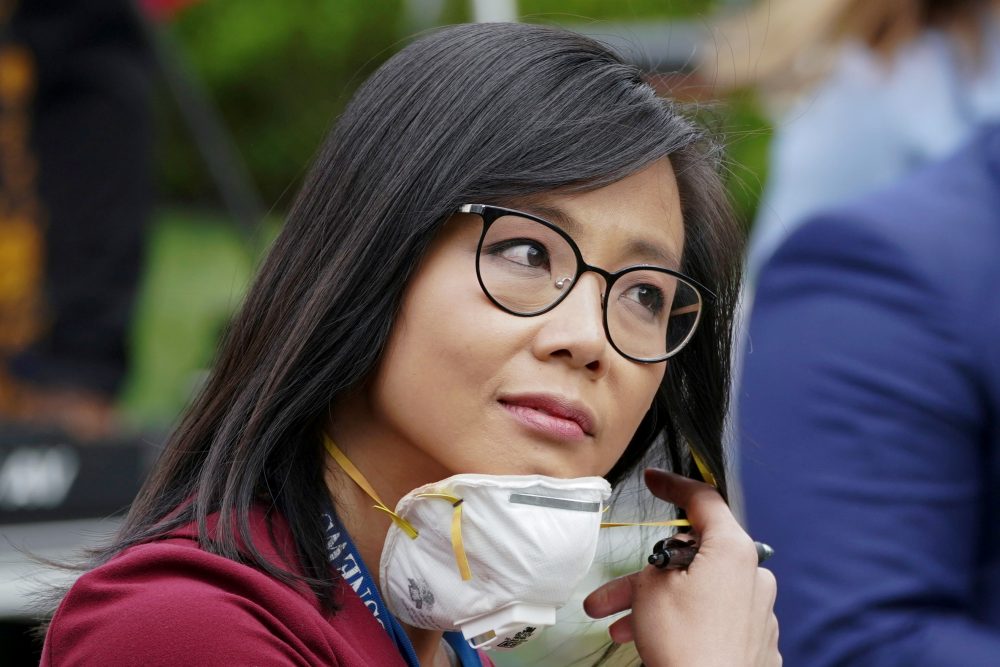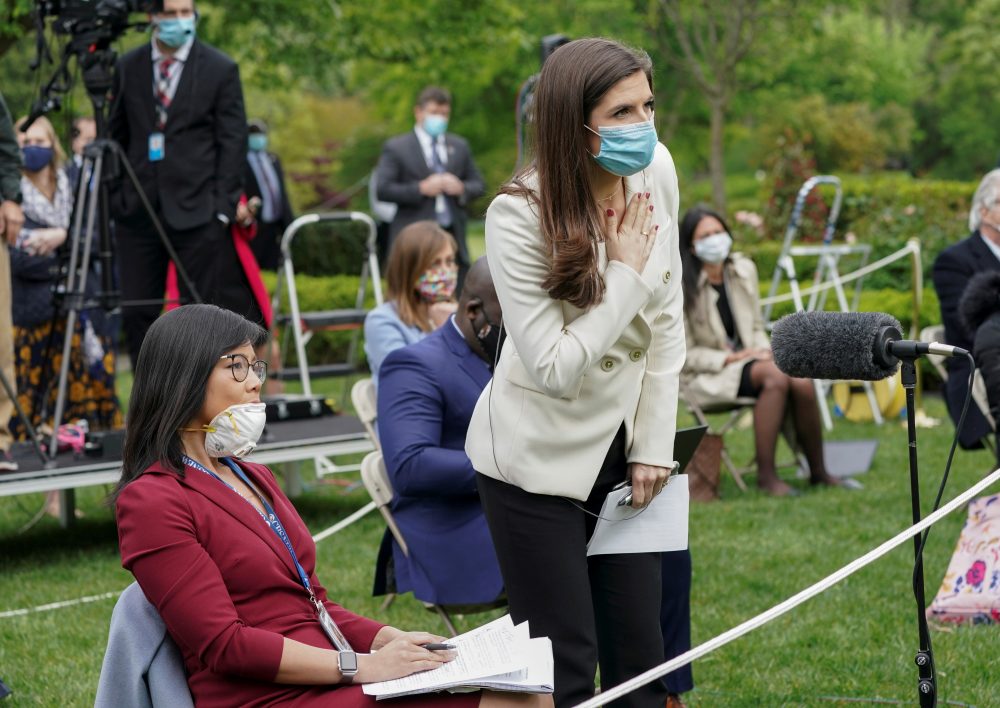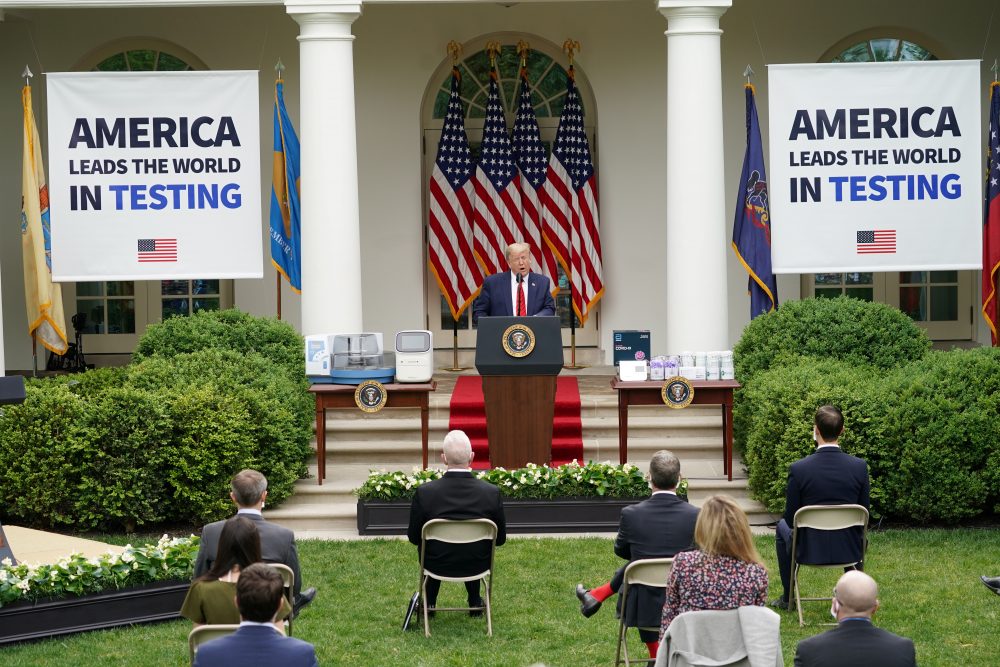U.S. President Donald Trump stormed out of a press conference about the coronavirus on Monday after a testy exchange with two female reporters, including one of Asian descent whom he told to “ask China” about the U.S. death toll.

The president fled after attempting to deflect a question from CBS reporter Weijia Jiang, who asked why Trump was treating COVID-19 testing as a competition amid tens of thousands of American deaths. Trump also suggested that the question was “nasty” — one of Trump’s go-to insults for women who challenge him.
The incident played out in the Rose Garden at the White House on Monday afternoon, where masked reporters were taking turns approaching stationary microphones to ask their questions. The microphones appeared to be switched off between questions.
“You’ve said many times that the U.S. is doing far better than any other country when it comes to testing,” Jiang said.
“Yes,” Trump replied.
“Why does that matter?” Jiang asked. “Why is this a global competition to you, when every day Americans are still losing their lives and we’re still seeing more cases every day?”
Trump, who rarely ever talks at length about the now 80,000 Americans who have died due to the pandemic, immediately took issue with Jiang’s question.
“Well, they’re losing their lives everywhere in the world,” he said. “Maybe that’s a question you should ask China. Don’t ask me, ask China that question, OK? When you ask them that question you might get a very unusual answer.”
Trump then pointed to CNN’s Kaitlan Collins for the next question.
“Sir, why are you saying that to me, specifically?” Jiang interjected, just as Collins was approaching the microphone. Jiang was born in China and emigrated to the U.S. at the age of two.
“I told you, I’m not saying it specifically to anybody,” Trump said. He then accused Jiang of asking a “nasty question,” and tried to move on entirely by skipping over Collins, despite the CNN reporter’s protests.
Collins insisted that she had questions to ask, and that she also wanted to give Jiang a chance to respond to Trump’s remarks.
“You called on me,” Collins said.
“I did, and you didn’t respond,” Trump said. He then abruptly thanked the press and bailed on the press conference.
Trump’s critics on Twitter immediately accused him of racism and “cowardice” for his sudden departure.
“Yesterday we saw two female reporters, who were doing their job, cause Trump to literally run out of the WH press conference,” actress Mia Farrow tweeted.

Get breaking National news
“He lost his nerve and retreated when met with honest questions by two reporters,” another user wrote.
Stephen Colbert accused Trump of throwing a “hissy fit” on Monday’s The Late Show with Stephen Colbert.
Trump “took his lack of balls and went home,” Colbert said.
Trump fired back with another of his go-to insults on Tuesday. “Fake Journalists!” he tweeted, along with a video that applauded him for walking away from “childish” reporters. He claimed in another tweet that the reporters were “conspiring” together.
The incident was reminiscent of Trump’s now-defunct daily coronavirus briefings, in which he regularly boasted about his accomplishments, sparred with reporters, blamed others for setbacks, promoted his own wishful timelines and touted unproven cures for COVID-19.
He stopped holding those briefings last month after he was widely mocked for suggesting that injecting disinfectant into a person’s body might cleanse them of the virus.
Trump has largely avoided talking about victims of the virus. He did acknowledge last month that he lost a few business associates to COVID-19, although he related the story very matter-of-factly at a press conference. He also offered his condolences to the family of a former business partner who died via Twitter.
Trump has frequently downplayed the threat of the virus and pushed for the U.S. to re-open to save its struggling economy, which he has tied to his re-election hopes in November. He has also boasted about raw coronavirus testing numbers in the U.S., despite public health experts’ warnings that the testing rate is still too low for a nation of 328 million people.

Harvard researchers have said the U.S. must process about 900,000 coronavirus tests per day to safely track new cases while re-opening. The U.S. is currently running at about 275,000 tests per day after a slow and widely criticized ramp-up in the early months of the outbreak.
Nevertheless, Trump spoke in front of huge banners on Monday that claimed, “America is leading the world in testing.”
America is also leading the world with 1.3 million cases of COVID-19 and more than 80,000 deaths from the virus. Data shows overall infection rates are falling, but that is in large part because hard-hit New York has managed to curb its outbreak. Infection rates are still on the rise in several other states, including ones on the verge of re-opening.
Trump has often described himself as a “wartime president” during this outbreak. He’s also started describing Americans as “warriors” in his push to re-open the country, while seeming to gloss over the fact that warriors tend to die in battle.
“The people of our country are warriors,” Trump told reporters last week.
“I’m not saying anything is perfect, and will some people be affected? Yes. Will some people be affected badly? Yes. But we have to get our country open and we have to get it open soon.”
—
Questions about COVID-19? Here are some things you need to know:
Health officials caution against all international travel. Returning travellers are legally obligated to self-isolate for 14 days, beginning March 26, in case they develop symptoms and to prevent spreading the virus to others. Some provinces and territories have also implemented additional recommendations or enforcement measures to ensure those returning to the area self-isolate.
Symptoms can include fever, cough and difficulty breathing — very similar to a cold or flu. Some people can develop a more severe illness. People most at risk of this include older adults and people with severe chronic medical conditions like heart, lung or kidney disease. If you develop symptoms, contact public health authorities.
To prevent the virus from spreading, experts recommend frequent handwashing and coughing into your sleeve. They also recommend minimizing contact with others, staying home as much as possible and maintaining a distance of two metres from other people if you go out.
For full COVID-19 coverage from Global News, click here.
— With files from The Associated Press












Comments